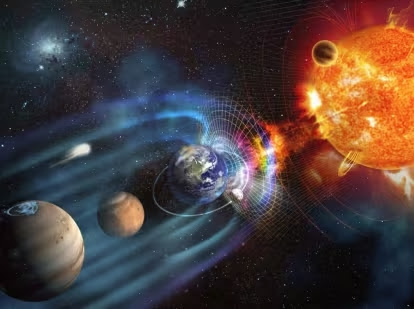GEOPHYSICS !
School all know that our planet Earth has usually physically different movements such as the Translation Movement , which is done around the Sun with approximate period of 365 Earth days . And the rotation which carries on its axis with a period of approximately 24 hours ground . But scientifically , are not the only types of movements that has our planet , there are other types that are almost imperceptible , the most important being those mentioned above.
But this time we will discuss about the internal motion presented by the inner core of our planet . Currently our planet is dynamic , so that all your internal and external matter is in constant motion, and as we explain in another post, is manifested by volcanic eruptions and major seismic events .
We should also remember that the Earth's magnetic field is related to the internal motion of the planet because the liquid outer core has a movement driven convection due to temperature , internal materials are in constant motion if frictions between releasing electromagnetic energy. And as we know the physics of electromagnetic flux , the energy released as a particular own characteristic magnetic field we already know, and that also protects us from solar plasma flows . We must also add that much of the pressure on the Earth's core and high internal temperature help to generate the respective magnetic field , which we call Earth and geodynamics .
Now the core of the Earth is its central sphere , the innermost of which constitute the structure of the Earth . It is composed mainly of iron, with 5-10 % nickel and minor amounts of lighter elements. (1)
Seismology provides evidence of the high density core . It is estimated that the average density of the core is about 11 000 kg/m3. Also , seismic data show that the core is divided into two parts , an outer core liquid of about 2270 km thick, a solid inner core with a radius of 1220 km and both are separated by Lehmann discontinuity .
Now, we know as how or what is the origin of the magnetic field , but how is the rotation of Earth's core ? Scientists at the University of Leeds, UK, have determined on the direction you turn the center of the Earth , which inner core consists of solid iron , makes a " super-rotation " toward the east, which means which rotates faster than the rest of the planet , while the outer core , composed primarily of cast iron, turns west at a slower pace . (2)
According to Dr. Philip Livermore , School of Earth and Environment , University of Leeds , in the UK, says : " ... The magnetic field pushes eastward into the inner core , causing it to rotate faster than the Earth , and also pushes in the opposite direction in the liquid outer core , which creates a westward movement ... " (2) by what we see then that the inner core rotates relative to the behavior of the outer core .
So what does the kernel have its motion? The answer is simple, the electromagnetic force.
Now, the interesting thing is that not always the inner and outer core of our planet have the same movement as these change constantly over time. But how such changes can explain the rotation of the magnetic field of our planet ? With evidence in rocks found and sampled in scientific research is concluded that in some periods of time the movement of the inner core to the east may have occurred in the last 3,000 years.
REFERENCES
(1) http://es.wikipedia.org/wiki/N%C3%BAcleo_de_la_Tierra
(2) http://www.europapress.es/ciencia/noticia-nucleo-interno-terrestre-gira-externo-oeste-20130917111515.html
School all know that our planet Earth has usually physically different movements such as the Translation Movement , which is done around the Sun with approximate period of 365 Earth days . And the rotation which carries on its axis with a period of approximately 24 hours ground . But scientifically , are not the only types of movements that has our planet , there are other types that are almost imperceptible , the most important being those mentioned above.
But this time we will discuss about the internal motion presented by the inner core of our planet . Currently our planet is dynamic , so that all your internal and external matter is in constant motion, and as we explain in another post, is manifested by volcanic eruptions and major seismic events .
We should also remember that the Earth's magnetic field is related to the internal motion of the planet because the liquid outer core has a movement driven convection due to temperature , internal materials are in constant motion if frictions between releasing electromagnetic energy. And as we know the physics of electromagnetic flux , the energy released as a particular own characteristic magnetic field we already know, and that also protects us from solar plasma flows . We must also add that much of the pressure on the Earth's core and high internal temperature help to generate the respective magnetic field , which we call Earth and geodynamics .
Now the core of the Earth is its central sphere , the innermost of which constitute the structure of the Earth . It is composed mainly of iron, with 5-10 % nickel and minor amounts of lighter elements. (1)
 |
| Diagram of the internal structure of the Earth. |
Now, we know as how or what is the origin of the magnetic field , but how is the rotation of Earth's core ? Scientists at the University of Leeds, UK, have determined on the direction you turn the center of the Earth , which inner core consists of solid iron , makes a " super-rotation " toward the east, which means which rotates faster than the rest of the planet , while the outer core , composed primarily of cast iron, turns west at a slower pace . (2)
According to Dr. Philip Livermore , School of Earth and Environment , University of Leeds , in the UK, says : " ... The magnetic field pushes eastward into the inner core , causing it to rotate faster than the Earth , and also pushes in the opposite direction in the liquid outer core , which creates a westward movement ... " (2) by what we see then that the inner core rotates relative to the behavior of the outer core .
So what does the kernel have its motion? The answer is simple, the electromagnetic force.
Now, the interesting thing is that not always the inner and outer core of our planet have the same movement as these change constantly over time. But how such changes can explain the rotation of the magnetic field of our planet ? With evidence in rocks found and sampled in scientific research is concluded that in some periods of time the movement of the inner core to the east may have occurred in the last 3,000 years.
REFERENCES
(1) http://es.wikipedia.org/wiki/N%C3%BAcleo_de_la_Tierra
(2) http://www.europapress.es/ciencia/noticia-nucleo-interno-terrestre-gira-externo-oeste-20130917111515.html































0 Comments:
Publicar un comentario
No olvides de escribir tu opinión personal de nuestro blog, una página o información que desees comprtir. Todos los éxitos para ti. Gustavo Zavala.